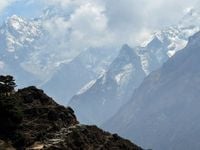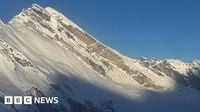Rescue teams are racing against time and the elements in Nepal’s Himalayas after a series of deadly avalanches and storms left at least nine climbers dead, several more injured, and a growing list of missing mountaineers—many of them foreign nationals. The calamity unfolded over the past week as unseasonal weather, blamed on Cyclone Montha, swept across the region, triggering heavy snowfall and avalanches at altitudes where even experienced climbers can find themselves at the mercy of nature’s whims.
The worst tragedy struck on Monday morning, November 3, 2025, when an avalanche crashed through a base camp near the summit of Mount Yalung Ri, a 5,600-meter (18,370-foot) peak in Nepal’s Rolwaling Valley. According to the Associated Press and corroborated by the BBC and Nepal’s Department of Tourism, at least seven climbers were killed in the disaster, among them three Italians, two Nepali guides, a German, and a French climber. The avalanche struck at roughly 09:00 local time, catching the group—who had set out over an hour earlier—off guard as they prepared for an acclimatization climb ahead of a planned ascent of the nearby Dolma Khang peak.
Eight other climbers, including three French nationals and five Nepalis, were rescued from the snow and flown to Kathmandu for treatment. Their ordeal was harrowing. French survivor Isabelle Solange Thaon, 54, recounted to the Associated Press from her hospital bed, “We were lucky because we were on the left. We lept over the rocks and swam in the snow until help arrived to pull us out. Unfortunately, Christian died because rocks hit his head.” Her husband, Christian Manfred, was among those who perished.
Rescue efforts faced daunting obstacles. Poor weather, ongoing snowstorms, and logistical challenges made it impossible for helicopters to reach the site on Monday. It wasn’t until Tuesday, November 4, that the skies cleared enough for rescuers to land and begin digging through the snow and debris. By that afternoon, three bodies had been recovered, but hopes of finding additional survivors faded as officials acknowledged that the remaining victims might be buried 10 to 15 feet beneath the snow, as reported by Mingma Sherpa, chairman of Seven Summit Treks, to the BBC.
The avalanche at Yalung Ri was not an isolated incident. Nepal’s Himalayan Times and Italy’s Ministry of Foreign Affairs confirmed that seven Italian climbers remain missing as of November 6, 2025, after heavy snowstorms and avalanches battered multiple peaks in the region. Communication between local authorities, rescue teams, and diplomatic missions has been described as “extremely challenging,” with confusion persisting over the exact number and nationalities of the missing. Italy’s foreign ministry stated, “There remains no news of seven other Italian nationals, including Marco Di Marcello and Markus Kircheler.” Both were last known to be in the Yalung Ri area when the avalanche struck.
In the same period, tragedy struck elsewhere. On Panbari Peak, a 6,887-meter (22,595-foot) mountain in western Nepal, two Italian climbers—Alessandro Caputo and Stefano Farronato—lost contact with their base camp on Friday, October 31, after heavy snowfall rendered communication and rescue efforts nearly impossible. Authorities confirmed on Tuesday, November 4, that their bodies had been recovered and flown to Kathmandu. The third member of their party, Velter Perlino, 65, and a sherpa were rescued, according to Nepal’s Department of Tourism and Italian media reports.
The recent spate of disasters has highlighted the unpredictable and often perilous nature of Himalayan mountaineering, even on peaks considered suitable for novices. Mount Yalung Ri, for instance, is typically marketed as an ideal destination for less experienced climbers seeking to taste the high-altitude adventure without the extreme risks associated with giants like Everest. Yet, as the events of this week have shown, even these “safer” mountains can become deadly under the wrong conditions.
Officials and rescue teams have been working around the clock, often in hazardous conditions themselves. Nepal’s Tourism Department director, Himal Gautam, emphasized the difficulties: “Rescue efforts were hampered by poor weather and logistical issues, which made it hard to fly helicopters or reach the site on foot.” Local police and trekking agencies have been coordinating to track missing climbers, but the terrain and ongoing storms have slowed progress to a crawl.
The impact of Cyclone Montha has been felt far and wide. Last week’s unseasonal rains and snow stranded trekkers and tourists across popular Himalayan trekking routes. Hundreds of hikers near Mount Everest found themselves trapped, and in western Nepal’s Mustang region, two British and one Irish woman had to be rescued after being stranded for days. Nepalese authorities have since issued urgent alerts to trekkers and climbers, warning of the heightened risk of avalanches and severe weather. The country, home to eight of the world’s ten highest peaks, draws thousands of adventure seekers each year, but the recent tragedies have cast a somber shadow over the autumn climbing season.
Back in Italy, the news has sent shockwaves through the climbing community and beyond. A senior Italian diplomat traveled from neighboring India to Kathmandu to help coordinate the search and rescue efforts. Families of the missing are clinging to any hope. According to Italy’s Ansa news agency, Marco Di Marcello’s family reported that his satellite radio signal was still updating and appeared to be moving, though officials caution that signals can be misleading in such terrain.
As the search continues, the mood in Kathmandu and the mountain villages is a mix of determination and grief. Survivors, like Thaon and Didier Armand, are coming to terms with their losses while expressing gratitude for the rescuers who braved the elements to save them. Climbing agencies and local guides, meanwhile, are calling for improved early warning systems and better coordination in the face of increasingly erratic weather patterns—an issue that has only grown more urgent as climate change brings new challenges to the world’s highest mountains.
The full toll of the past week may not be known for days, if not longer. But one thing is clear: the Himalayas, for all their beauty and allure, remain as unforgiving as ever—reminding climbers and rescuers alike that every ascent is a gamble, and every safe return a victory against the odds.


